Spoiler: I Have no Answers
Berlin
Every Connecticut town has its mysteries. Some are famous like Gungywump in Groton, and some are pretty much only known to me like the Mystery Pits in Somers. But Berlin is different to me because its mysteries are right there! In your face! And yet, I can’t seem to land on any definitive answers to any of them. Furthermore, Berlin is such an unassuming little town, smack dab in the center of the state – which coincidentally relates to one of the mysteries.
Perhaps someday, as a result of this page and the huge Berlin, Connecticut fanbase I have, we’ll get some clarity on at least a couple of these issues. We’ll do this McLaughlin Group style…
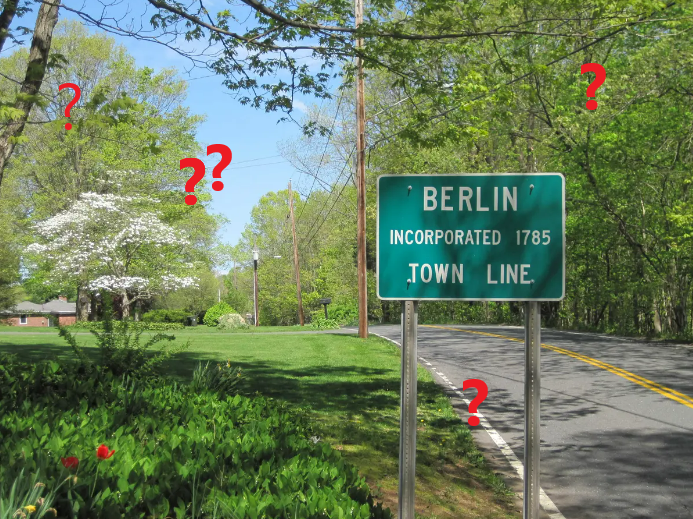
Issue One! The town’s name!
The area that is now Berlin was originally know as Pagonchawnischage (the great white oak place), by the Mattabasset Indians. In the early 18th century, parts of Farmington, Wethersfield, and Middletown were added to increase what was then called Kensington – which today is a section of Berlin. 1785 brought incorporation of the town, which was suddenly called Berlin. Mildly interesting digression: New Britain remained a part of Berlin until 1850.
No one definitively knows why they chose to name the town after the German city. There’s some thought that it was named after an English lord or a German immigrant, but… what was wrong with Kensington? Or Worthington – another section of what is now Berlin?
Okay, whatever. We have Berlin. Fine. But how do you pronounce it? The obvious pronunciation – ber-LIN, like the famous capital of Germany – is wrong and locals hate it. You will likely be corrected if you emphasize the wrong syllable.
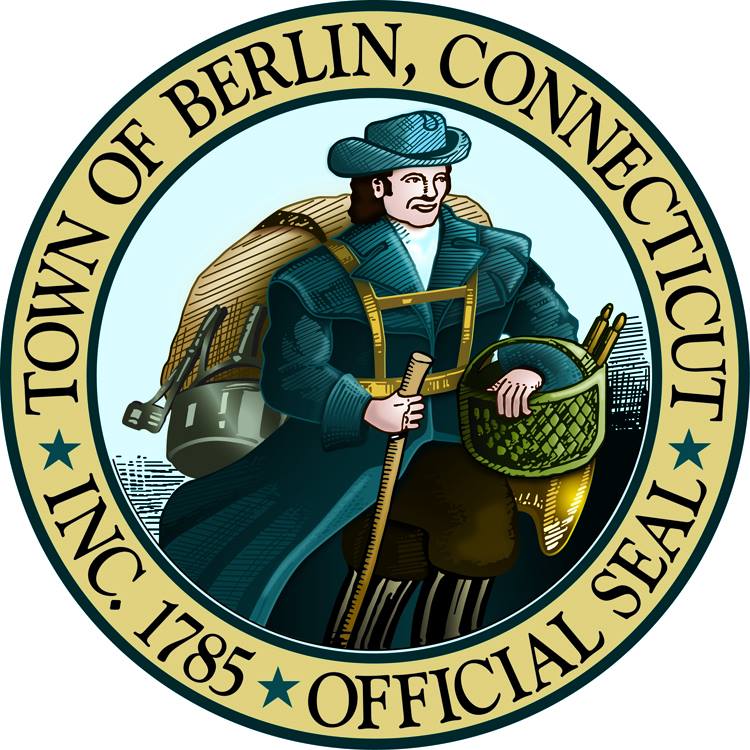
For the record, it’s BER-lin, emphasis on the first syllable. But apparently that wasn’t always the case. “We honestly have nothing we can find in our records that explains it,” said Kate Kearns, president of the Berlin Historical Society, in an old Hartford Courant article.
Kay Murray, the town historian, said the best guess about the unusual pronunciation is sort of a “freedom fries” moment dating back to America at the outbreak of World War II. Yeah. Remember that nonsense? Our elected officials focus on the dumbest stuff. (I’m referring to the short-lived and impossibly stupid push in 2003 by several congressmen to change French fries to “freedom fries” on US House cafeteria menus to rebuke the French government for refusing to support the U.S. position on Iraq. For real.)
And BER-lin might be the same type of thing. The story goes that until WWII, Berlin was pronounced like the German capital… apparently Germany’s WWI exploits weren’t bad enough. (Actually… at the end of World War I, anti-German sentiment sparked calls to ban teaching of German in schools and performing German music and operas. Also, there was a movement to force sauerkraut to be called “liberty cabbage” and bratwurst “liberty sausage.”)
So the story goes that after the war started, nobody wanted anything to do with Berlin, Germany. So the pronunciation changed. The town historian admits, though, that there is no documentation of any of this. Lots of old timers back this explanation up though, so if that oral history is good enough for you, it’s good enough for me.
But man, think about that. It would have been reeeeeeaalllly difficult to convince 10’s of thousands of people to start referring to their hometown, or their neighboring town, differently.
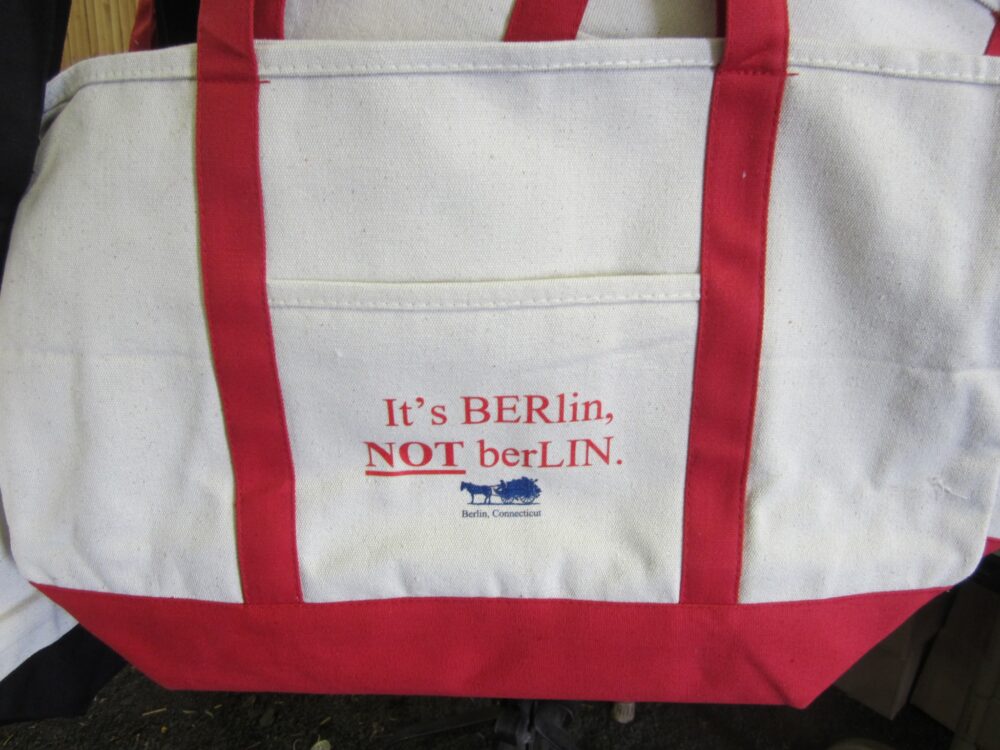
Update: Hoo boy, I had no idea this could be so contentious. Several people have reached out with thoughts and ideas, but I’ll leave the last word to reader Lorraine Stub – who contradicts the Historical Society even though I believe she volunteers there:
Sighhhh. As a native, life long BER-lin resident whose family goes back to the 1880s, I can refute stories about the pronunciation changing. When I was a growing up, I asked my grandmother, who was born here long before WWI, if she always pronounced it BER-lin, and she emphatically said “Yes”, as did other relatives of her age. She said nothing changed when we went to war with Germany, though there was some talk about changing the name completely.
As for why it was named Berlin, it may have been a compromise. The original Congregational Parish had split with one group keeping the name Kensington and building a meeting house to the West on what is now Percival Avenue and the other group building a meeting house to the East, naming it Worthington. When an official town was formed in 1785, it makes sense a compromise was made on the name.
It is thought that because Frederick the Great of Prussia (pre-Germany, Berlin was Prussia’s capitol) was greatly admired for being a supporter of our revolution, and for being an enlightened leader. If you’d never traveled to Germany, known Germans, and only read of such things, it’s easy to understand that the New England dialect could result in a different pronunciation of the name. There are many other BERlins in New England and elsewhere.
That last point is a very, very good point. Thanks!
We’ll call this one: Probably Solved!
![]()
Issue Two! Where is the Center of the State?
The geographic center of Connecticut is in Berlin. In fact, it’s in a swamp behind the house at the intersection of Mill Street (Rte 372) and Middletown Road. It’s somewhere in the middle of this picture:
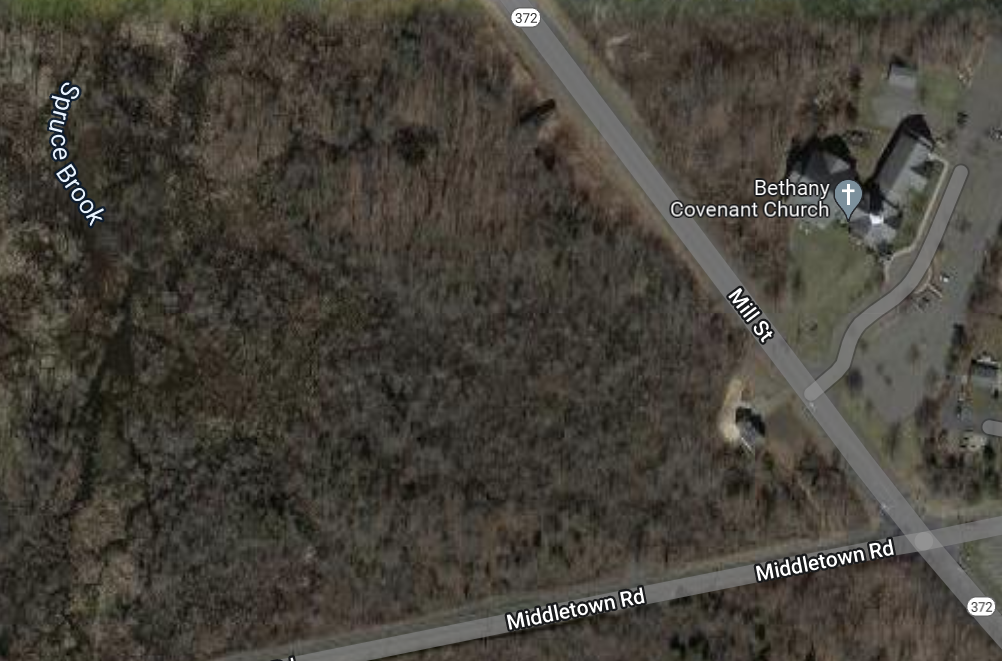
As a geography geek, I’ve always wanted to stand in the geographic center of the state. We mark everything else here, but why not this?
I was actually told by an elderly woman at the town’s historical society way back in 2007 that it was her understanding that there was a marker in those woods at one time. I know people – seriously – that have traipsed around back there to no avail.
I used to drive past this spot every day for years when I worked at the old Middletown Aetna office and I can’t tell you how many times I’ve thought about looking myself. I still probably will, and I’ll surely document my foolhardy mission.
But Berlin, bro, you have a very important geographic point in your woods. Erect an obelisk! You don’t even have to tell anyone other than me. Just let me know when you do, okay?
Updates: Within one day of publishing this, I received many comments and claims. I liked this one, “I was told by an old timer that there is no marker in the swamp. The story that one was once there is one seniors used to prank freshmen with like the pool on the roof gag.”
Ha. But my friend Lorraine chimed in with:
A long ago previous owner of the house, Ruby Nye Morse, documented the “marker” in notes she wrote in the 1930s about it being an oak tree in the swamp behind her house. Problem is trees don’t live forever and that tree died. We have her notes in a letter at Berlin Historical Society Museum.
I have made a promise to go back there just to see that note. I’ll keep you posted.
Let’s say: Disappointing Solved!
![]()
Issue Three! The High School’s Seal!
It’s a lamp. A genie lamp. With Genie dust rising from it.
Why is the school’s seal a genie lamp? I don’t know. I do know that school’s yearbook is called “The Lamp” though. (My high school yearbook was called “The Azurean” which I guess is also sort of weird, but I know why it is called that at least.)
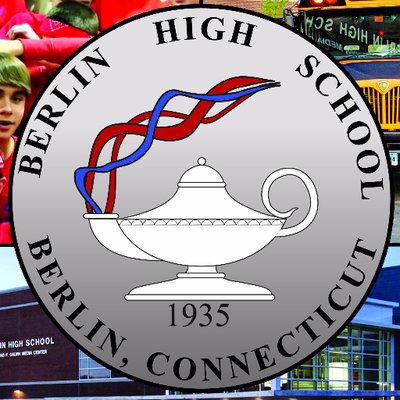
Now, Berlin was once famous for its tin manufacturing. Back in 1740, William and Edward Pattison arrived in town from Ireland. They brought with them a few sheets of tin, and began to make tin items. They soon began to peddle their wares from door to door. This was the start of the “Yankee Peddlar” and the beginning of tin manufacture in this country.
Cool. And that’s why the town’s seal is the Yankee Peddler. Did tinsmiths make a bunch of genie lamps? Does a genie lamp somehow play into the high school’s mascot? NO! NOT AT ALL!
Update: I knew someone would answer this one, as it is the most straightforward. Lorraine, again: The “genie” lamp is in reality the Lamp of Knowledge. It was designed by student Joseph A. Simeone in 1936 for the class ring.
This one is definitely solved!
![]()
Issue Four! The High School’s Mascot!
The Redcoats! As in, our embryonic country’s mortal enemy Redcoats? Apparently, yes.
I first became aware of the mascot while hiking some trails around the high school’s sports fields at Sage Park. (Remember, I’m not from Connecticut.) So I spent a long time trying to wrap my head around the fact that the Redcoat guy actually looks British and is carrying a musket straight out of Revolutionary War times.
Others chimed in that they, too, have questioned this in the past.
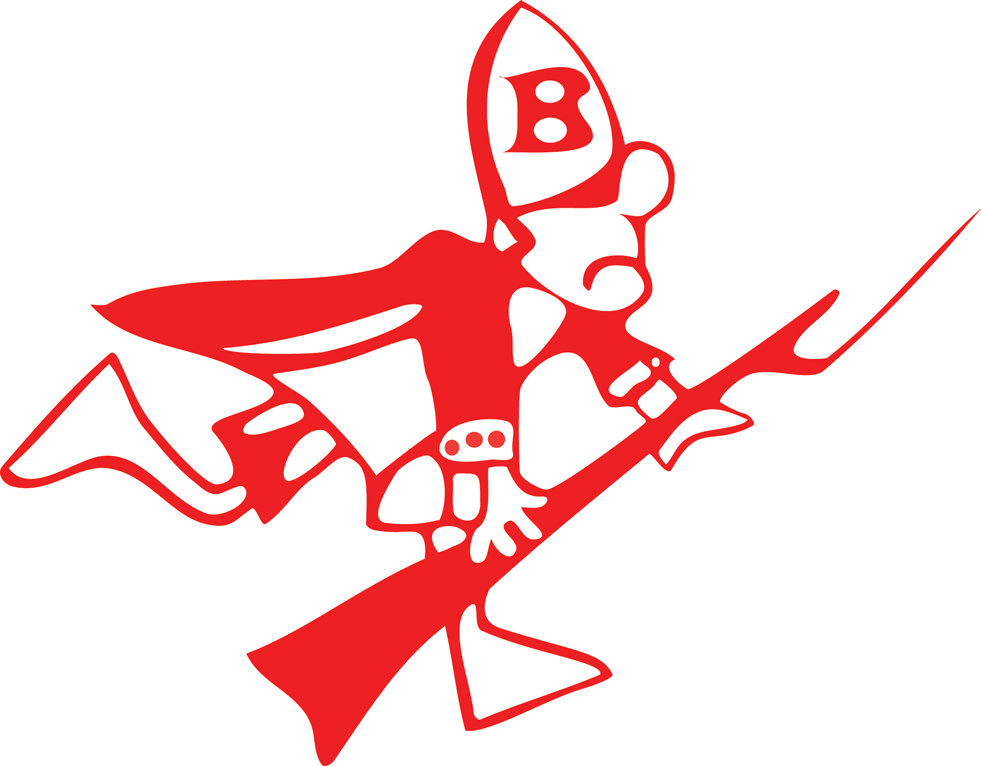
I don’t have any answers right now and am left to wonder why there’s a town in Connecticut that shares a name with the city that more or less birthed Nazism with a high school mascot honoring one of our countries most infamous enemy forces.
So Berlin, I’ve gotta ask, What’s up with you?
[Literally 2 minutes later…]
What’s that? Someone has an explanation?
Just as this was about to go to press, I went looking for a good mascot picture. And lo, I found a Facebook explanation… of sorts.
Art Kevorkian says…
I write this every time the name Redcoats comes up and nobody believes me. Alfred “Hunk” Anderson was the high school coach from 1938-1943 Howard Goding a Berlin resident replaced for the 1944 season. Bill Gibney started in 1945 and my father and Roy Fabian were his assistants. They also were drinking buddies with Hunk after the war where my father coached the New Britain Codys Semi-Pro football team where Hunk was an assistant and Roy Fabian played on. Since they both taught at BHS they asked Hunk how the name Redcoats came about. This is it……….
Hunk says “it was 1939 or 1940 and they were playing Canton at Percival Field when it started to rain heavily. During halftime the team went under the bleachers for shelter. Hunk who had been painting his house red went to his car and came back with a bunch of red tarps and gave them to the players for cover and said “now you’re Redcoats”. Sounds weird but I myself verified this. Back in 1946/47 Hunk dated a new young Berlin High History teacher named Vi Thompson. Back in 1967 I was a History teacher and coach at BHS and once asked Vi if that story was true. She sheepishly grinned and said yes. The Redcoat patches were the logos of the Boston Patriots, quite appropriate for our Redcoats. There you have it…Believe it or not!
Man, if that story isn’t straight out of Archie’s Comics, I don’t know what is. Anyway, here’s an old mascot. Which was more of a New England Patriot – the literal opposite of a British Redcoat! So weird!
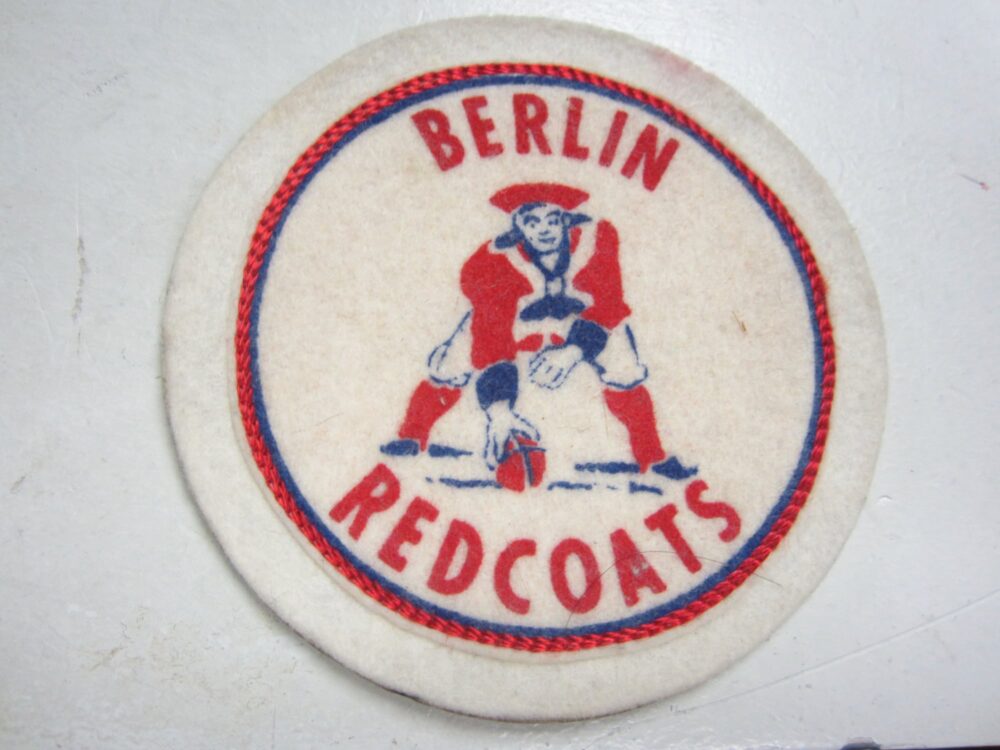
Weirder? The Berlin Historical Society notes another theory (brickmaking was big in town and brickmaking makes red dust that coats coats) but moreover, the British soldier mascot doesn’t seem to come into play until 1988. And despite its recency, no one knows why. The Society’s response to the above comment and more:
Art Kevorkian’s account makes sense, but it is documented there was an official contest to name the team. Back in 1936 when the new high school had its first graduating class (the Jean E. Hooker addition to KGS was the first high school here), there was a contest publicized in the New Britain Herald to name the team. The winning entry was “the Red Coats” – submitted by Grant “Pinky” Dodson. Maybe Dodson submitted that name as a result of the red painted tarp story? Unfortunately there is no explanation in old news articles as to why that name was selected. Old timers have offered that it was because the team did wear red jackets. There are other theories about the brick industry in town and that workers were covered in red clay dust. One of the rejected entries to the contest was “Bricklayers”. The red jacket theory seems the most plausible.
I must point out that the Berlin basketball teams would have had difficulty dealing with being called The Bricklayers. Sorry… you were saying Berlin Historical Society?
Most of us currently in the Historical Society went to school during the 1950s to early 1970s and we can’t recall any mascot. The soldier mascot does not seem to appear until 1988 when that class paid to have the logo of a British soldier (we think it may have been drawn by Bob Dornfried) put on a “Home of the Redcoats” sign that we see outside the school. (Note – the soldier patch just brought to our attention has caused us to re-examine our memories).
It does seem strange that the teams would have adopted that image as the mascot given we fought the British Redcoats for our independence during the Revolutionary War. Maybe this is just one of Berlin’s quirky stories that will forever beg to be resolved.
Indeed. So I guess this isn’t actually solved after all.
So I say again… Berlin! What is up with you? Maybe solved but maybe not
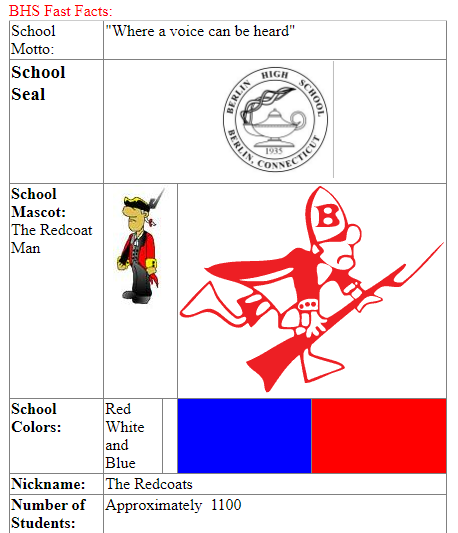
![]()
CTMQ’s Town Essays
CTMQ’s Guide to Berlin

 Tom Fatone says
Tom Fatone says
December 14, 2022 at 8:39 amSteve
If you would ever like to go look for the marker, I’d be more than happy to join you. I would love to take a picture next to it as well. Is it private land??
Tom
 Steve says
Steve says
December 14, 2022 at 9:56 amLOL, I know you have been wondering about this for years as well. It is privately owned land. It’s a swamp and a big mucky mess, so the chances that someone has actually put a marker in there are slim to none.
It’s fun to think about though. I’ll let you know.
 Greg Amy says
Greg Amy says
December 15, 2022 at 7:58 amHow is “geometric center of a state” determined? intersection of corner-to-corner lines? something else? Should be easy to find with a lat/long, no?
As I’m sure you’re aware, the city of BER-lin has a GIS search that can give you the contact info for all property owners. You could send a letter with your contact info, asking for permission to walk the property. Most people will initially be suspicious, but if you ask sincerely then most will usually agree, and may very likely want to join you in the search!
I don’t want to “dox” that person with a direct link, but property information is publicly available at berlinct.gov
 Steve says
Steve says
December 15, 2022 at 8:57 am“Geographical” I guess is also “geometric.” It’s a whole thing and obviously determining it for, say, Wyoming is easier than Connecticut (let along Hawaii). But the people who care about this stuff have their ways. (There’s also “population centers” of every state and country. For CT, that’s in a residential neighborhood in Cheshire, since the more populous Fairfield County draws that center southwest from the geographic center.
And yes, I know exactly where it is Long/Lat-wise. I’ve actually spoken to the homeowners who were well aware of their important place in CT geography. But there’s no ‘there’ there, so… I’ll figure it out.
 Joy Sweeney says
Joy Sweeney says
February 20, 2024 at 4:28 pmMy daughter & I have literally stood next to the sign and it was just a stick on a pole and it said, ” you are standing in the middle of Ct” with the geographical coordinates so I can 100% say the sign exsisted 4yrs ago. You can only find it during cold months when everything has fallen off trees. We did take a picture so if we ever find it, will share for all!!
 Catherine S. Lapollo says
Catherine S. Lapollo says
March 12, 2024 at 11:33 amPlease correct the post re: Issue #3 – The High School’s Seal. Thanks.
It was designed by student
(** wrong -Frank **) Simeone in 1936 for the class ring.
My father, Joseph A. Simeone, created the design. He was the class president of the first BHS graduating class. More information can be found in that yearbook.
 Jacki says
Jacki says
December 22, 2024 at 5:56 amWow interesting stuff. BHS class of 1970.
My great grandfather was Anthony Carusone. Named changed to Carson
My gramps was Nick Carson the Barber who owned Hollywood Barbershop.
There is an underbelly of scandal in Berlin Ct. Along with many positive historical facts. My great grandfather bought the small farm at 964 Farmington Ave. in late 19 th century.
The railroad company was selling land so he added real estate to his home. At one point he purchased all the property which currently began at his home now part of the Farmington Ave. bar and grill … straight to Pleasant street where he built three substantial homes for himself and his kids. His property encompassed Carson Autobody … the second structure to house the body shop. And Berlin Pharmacy the original brick structure was built on his farmland. Imo we were supportive during the Revolution of the Brits. Not the patriots. And we relagated a large population of former slaves to the edge of Christian Lane where many resided still when I was a small child in the 1950’s. The Italian population came to town on an invite beginning in the 1870’s to work the brickyards and railroad . The ground was too soft to build up the industries that populated New Britain. And immigration and slavery factored into this towns deep seated attitudes. Imo. Scandals unspoken abound from the Prohibition ERA and the activity of youth gangs in the 1930’s and some terrible crimes. And in 1959 the FBI came to town and raided my uncle ‘s Stag Party. I could expound but that would embarrass too many relatives. And won’t lend to the positive aspects of growing up in Kensington / Berlin. And my grandfather was born in Kensington in 1896. The pronunciation is related to our British immigrants. Not to Germany. We have a large settler class of Brits that arrived for the Industrial Revolution.
 cathy nelson - berlin-peck local history volunteer says
cathy nelson - berlin-peck local history volunteer says
January 20, 2025 at 4:50 pmjust saw your page – fun –
I researched many of these same topics. The geo- center of Ct: I contacted the US Geological Service – this designation was made about 100 years ago, before gps systems. They used slide rulers. They designated the area of town called East Berlin. There was no marker. It’s up to each town or state to erect one and Berlin nor CT ever did so. Periodically wither the New Britain Herald or Hartford Courant will explore the topic.
Name of town – no one knows: my theory is the town representatives wanted something totally neutral – so the town is NOT Kensington, Worthington, or any other name already associated with the town.
Pronounciation – newspapers had a bit about how to pronounce the name during world war one – and of course again in world war two. nothing ever really happened.
if you want I can send the newspaper articles